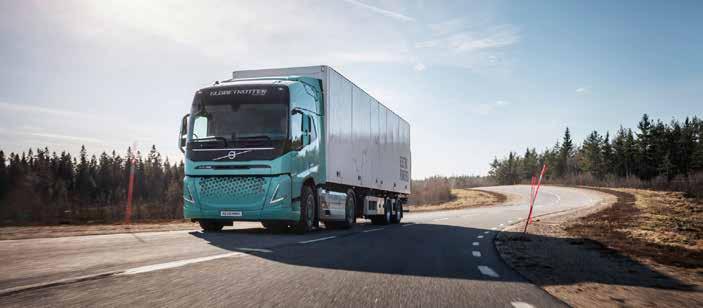
5 minute read
Sustainability
The route to zero carbon
Volvo Trucks: Heavy-duty electric concept trucks
Climate change affects us all; and when looking at the causes of climate change, supply chains and supply chain organizations are far from blameless, writes Dr. Omera Khan in a recent Whitepaper.
Climate Change is real, and it has now the World Resources Institute, in 2016, The 10 point plan warehouses, various transportation turned into a severe global threat the transport sector for the first time modes—collectively, they are significant as we experience aggravated and surpassed the electric power industry as consumers of energy, and significant frequent droughts, heat-waves, forest GREEN PUBLIC TRANSPORT,the single greatest source of greenhouse OFFSHORE WIND emitters of carbon dioxide. fires, hurricanes, floods, and storms in CYCLING AND WALKING gases in the United States. And it isn’t enough for businesses every corner of the globe. In Europe, where most other sectors of to simply reduce their emissions: that
This white paper focuses on the central the economy have reduced their carbon will merely slow the pace of climate role of Supply Chain Organizations in dioxide emissions since 1990, emissions change. For atmospheric carbon dioxide climate change and the rise of the issue NUCLEAR POWER from transport have risen—and continue HYDROGEN concentrations to stabilise, and then due to emissions of carbon dioxide as a to climb. actually reduce, net new emissions of result of their business operations and carbon dioxide need to be zero. Hence what motivates them to deal with it to reduce their impact effectively. JET ZERO AND GREEN SHIP Slashing emissions GREENER BUILDINGSS the goal of ‘zero carbon’, a mantra that is increasingly being heard within supply
Dr. Omera Khan has carried out in-depth Cutting those emissions is a major global chain organizations research on the topic and has carefully priority. As consumers, many of us are formulated the white paper, covering every CARBON CAPTURE, US & STORAGE (CCUS) AGE already making a difference—I know that ZERO EMISSION VEHICLES relevant aspect of the relationship between I am. You probably are too. But it is the Supply Chain Organizations and the world’s businesses and industries which ongoing climate crisis. collectively contribute a major proportion
In 2018, 24% of global greenhouse PROTECTING OUR NATU ENVIRONMENT RAL of the carbon dioxide emissions that are GREEN FINANCE AND INNOVATION gas carbon dioxide emissions came warming the atmosphere. about from transportation. According to Factories, offices, data centres,
NET ZERO INNOVATION PORTFOLIO - PRIORITY AREAS
Advanced Modular Reactors of Floating fshore wind Hydrogen Bioenergy Industrial fuel switching
Advanced CCUS Homes Disruptive technologies Direct air capture Energy storage and flexibility
Zero carbon
‘Zero carbon’? Is that even possible, I hear you exclaim? Well, maybe not immediately, for sure. However, there’s nothing wrong with having audacious goals. There is nothing wrong with being encouraged by progress that is already being made towards zero-carbon around the world.
Look at the United Kingdom: in the first three months of 2020, renewable energy made up an impressive 47% of the country’s electricity generation. Here in Denmark, where I’m living right now, the use of renewable energy is even higher, with over half the country’s energy usage in 2019 already being met from renewable sources, chiefly wind power.
And in terms of transport, the authoritative Energy Transitions Commission concluded in a

report published in 2018 that the decarbonisation of a lot of transport was also indeed attainable over the longer term—through developments such as electrification, bio-fuels, improved energy efficiency, and modal shift.
Fresh start
Supply chain organizations can make a start towards zero carbon right now. This is owing to the fact that decisions about where—and how—products are sourced, manufactured, warehoused, and transported have a significant impact on carbon dioxide emissions.
We also have the same scenario with outbound supply chains, of course. The journey from the assembly line to the final customer may involve a chain of custody stretching through multiple intermediaries—distributors and logistics partners alike—each with their own handling and storage operations.
At each stage, as goods move between these various intermediaries, transport is required: road, rail, air, or sea as appropriate, each with different carbon footprint.
So yes, one aspect of zero carbon is undeniably about technological developments, some of which are admittedly far off in the future. Electrifying the world’s truck and van fleets won’t be either easy or quick. And cleaning up air freight and sea freight is probably even further off.
Roadmap
Importantly, the route to zero carbon is also about things that supply chain organizations can make a start on right now: sourcing differently, changing outbound and inbound supply chain practices and designs, and making conscious efforts to invest in energyefficient factories, warehouses, and distribution hubs.
As I point out in a just-published paper for The Supply Chain Academy, The Route to Zero Carbon plenty of companies are doing just that. Across five continents, Unilever is already using electricity from renewable energy sources in all of its manufacturing and distribution operations, with the goal of them relying entirely on renewable energy by 2030—just a decade away.
Maersk, the world’s largest shipping container company, aims to have carbon neutral vessels in commercially viable operation by 2030, replacing older vessels with new and efficient ones.
As another example, UK facilities management outsourcing firm Mitie has committed to transitioning its entire 5,300 strong vehicle fleet to zero emission electric by 2023, with 20% of them having made the switch to all electric by the end of 2020.
People centric
Yet one of the biggest barriers to achieving such things lies not in technology, but in people—in other words, equipping our supply chain organizations with the leadership, skills, vision and direction to take ownership for making this happen, and accelerating its pace.
Talk to supply chain professionals, and there’s widespread agreement with this. What is more, there is also widespread agreement that it’s not ‘hard’, technical skills that matter most, but so-called ‘soft’ skills—the skills required to influence, persuade, collaborate, and communicate.
Constant interaction
Why? This is because supply chain organizations—and the leaders of supply chain organizations—don’t operate in a vacuum. At every stage, there are people to talk to, people to persuade, and people to convince. The long list includes employees at multiple levels, CFOs, Boards of Directors, customers, suppliers, logistics partners and other multiple constituents and stakeholders.
Ed Weenk, of Maastricht School of Management, summed it up well when I interviewed him for the whitepaper.
“The world is changing, and it’s changing fast. Cross functional thinking, creative problem solving, influencing skills, being able to ‘speak the language’ of other functions: It is soft skills like these that will determine progress, and deliver success.”
How right he is!

Prof. Dr. Omera Khan is recognised as global thought leader in Supply Chain Risk Management and Resilience. She is Professor of Supply Chain Management at Royal Holloway, University of London, and Executive Strategy Advisor for Supply Chain Academy.








